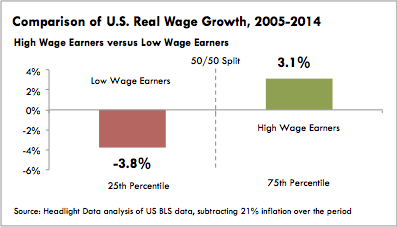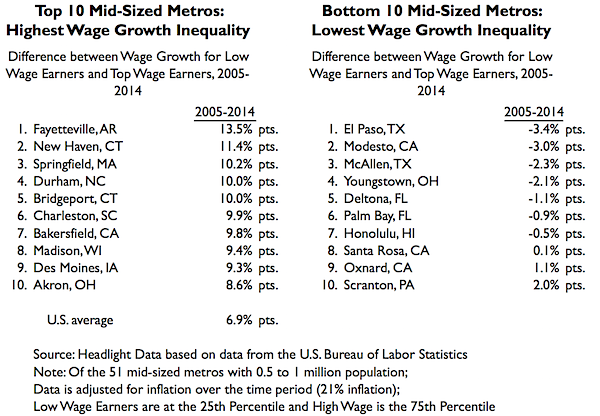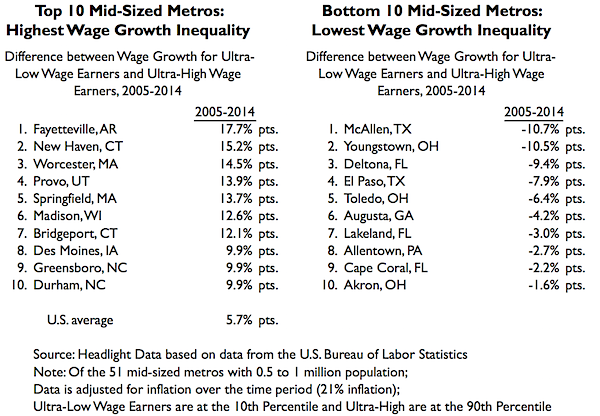05 Nov 2015 Wage Growth Inequality Among Mid-Sized Metros is Highest in Fayetteville, New Haven, Springfield; Lowest in El Paso
As explained in a previous article for large metros, wage growth inequality can be defined as the difference between the wage growth for two different levels of wage earners.
Workers are split between “High Wage” earners and “Low Wage” earners. High Wage earners are those in the right half of the chart below and have a median wage at the 75th Percentile. Low Wage earners have a median wage at the 25th Percentile. The difference in wage growth from 2005-2014 of these two groups is an indication of whether inequality has gotten better or worse over time.
Overall for the US, High Wage earners enjoyed a 3.1% increase in their real median wage, after accounting for inflation. Low Wage earners witnessed a 3.8% fall in their wage.
(See footnote for a full explanation of percentile levels and wage groups)
Wage growth inequality for mid-sized metros since 2005 was highest in Fayetteville (a 14 percentage point difference in growth rates), followed by New Haven (11 percentage pts.) and Springfield (10 percentage pts.). Seven of 51 mid-sized metros experienced a decrease in wage growth inequality, i.e. where wages for low-wage earners grew faster than high-wage earners. The largest inequality decrease was seen in El Paso (-3 percentage pts.), Modesto (-3 percentage pts.) and McAllen (-2 percentage pts.).
Click here to see this data mapped in Tableau Public. Permission is granted to embed this map in any website. Click the “Share” button to get the embed code.
Examining the extremes of the spectrum – Ultra-High Wage earners (top 20%) versus the Ultra-Low Wage earners (bottom 20%) – wage growth inequality was worst in Fayetteville, New Haven and Worcester. Twelve out of 51 mid-sized metros saw a decrease in inequality, led by McAllen, Youngstown and Deltona.
Click here to see this data mapped in Tableau Public. Permission is granted to embed this map in any website. Click the “Share” button to get the embed code.
Note:
The U.S. Bureau of Labor Statistics releases percentile wage estimates as part of the Occupational Employment Statistics data. The median wage is the wage of workers in the middle of the distribution of all workers. Wages are also provided at the 10th, 25th, 75th, and 90th percentile. For example, the 25th percentile wage estimate is the wage value in which 25% of workers have lower wages. In 2014, North Dakota’s 25th percentile annual wage was $25,910, meaning that 25% of North Dakota employees earned less than $25,910 that year.
The percentile wage levels are used to form the following wage groups:
- Ultra-Low Wage Earners = Bottom 20% of wage earners, whose median wage is at the 10th percentile.
- Low Wage Earners = The bottom half of all wage earners, whose median wage is at 25th percentile.
- High Wage Earners = The top half of all wage earners, whose median wage is at the 75th percentile.
- Ultra-High Wage Earners = Top 20% of all wage earners, whose median wage is at the 90th percentile.
Click here to download a spreadsheet of the data.
Research, analysis and content developed by Headlight Data.
About Headlight Data:
Headlight Data is an award-winning online data aggregator, designed for economic and workforce development organizations, that provides online, decision-support tools on the economy, demographics, education, workforce and public policy.
Baton Rouge, Charleston, Provo see Largest Growth in Median Wage For Mid-Sized Metros Since 2005; Youngstown Wage Declined the Most
As described in a previous article for large metros, wage performance can be examined at ... Read more
North Dakota has Fastest-Growing Median Wage Since 2005; Michigan Wages Declined the Most
As first described in a previous article for large metros, wage performance can be examined ... Read more



